National Immunization Awareness for Your Pets
August 12, 2024
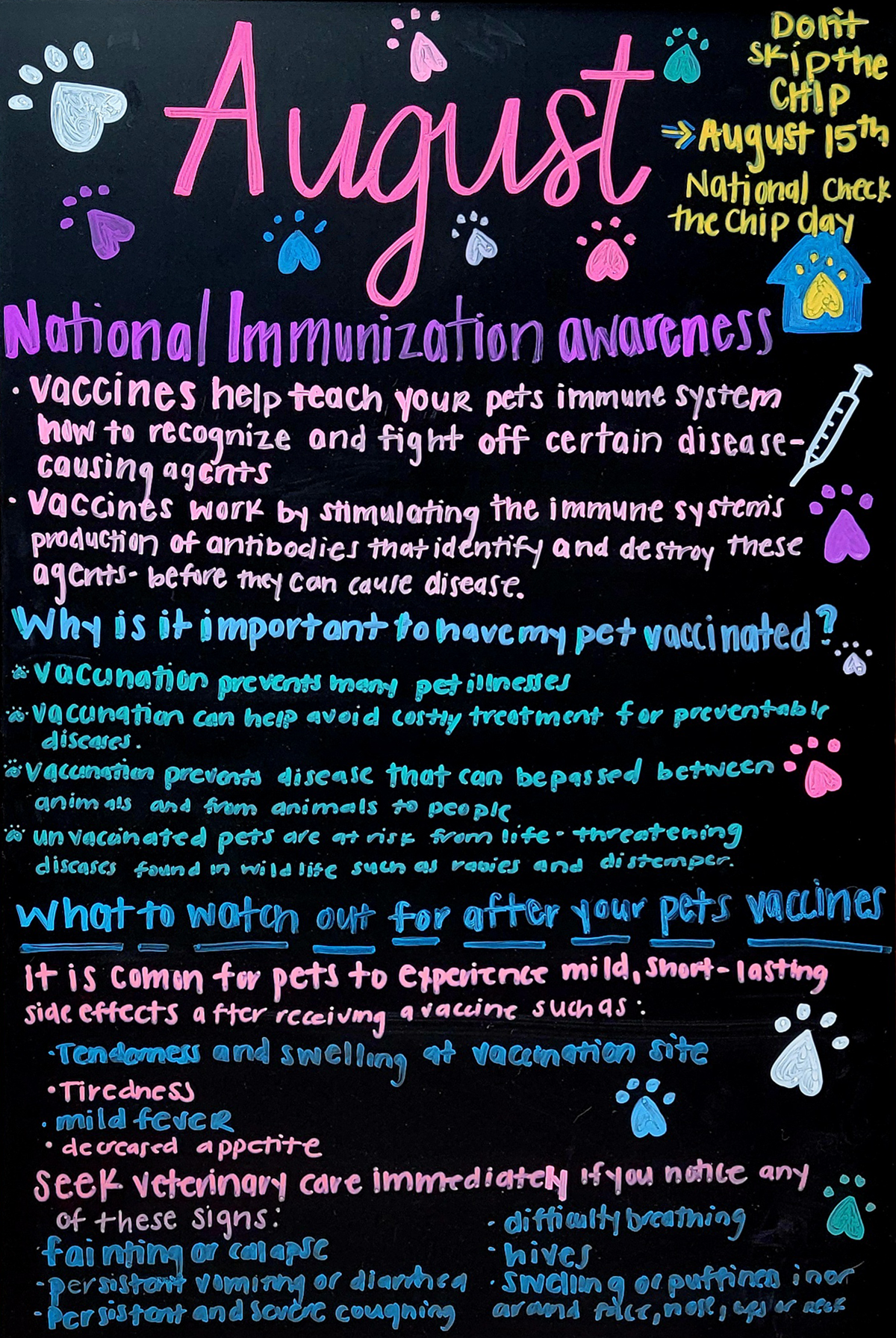
August is a Great Time to Get Caught Up on Pet Immunizations
Let’s kick off National Immunization Awareness month with some information about vaccines for your pet:
- Vaccines help teach your pet’s immune system how to recognize and fight off certain disease-causing agents
- Vaccines work by stimulating the immune system’s production of antibodies that identify and destroy these agents– before they can cause disease
Why is it important to have my pet vaccinated?
- Vaccination prevents many pet illnesses
- Vaccination can help avoid costly treatment for preventable diseases
- Vaccination prevents disease that can be passed between pets and/or farm animals to people (zoonotic disease)
- Unvaccinated pets are at risk from life-threatening diseases found in wildlife, such as rabies and distemper
What to watch out for after your pet’s vaccines
It is common for pets to experience mild, short-lasting side effects after receiving a vaccine, such as:
- Tenderness or swelling at vaccination site
- Tiredness
- Mild fever
- Decreased appetite
Seek veterinary care immediately if you notice any of these signs:
- Fainting or collapse
- Persistent vomiting or diarrhea
- Persistent and severe coughing
- Difficulty breathing
- Hives
- Swelling or puffiness in or around the face, nose, eyes or neck
See our Immunization Resources for more information on vaccines and diseases they prevent, such as heartworm and leptospirosis.
Read More
Lepto Vaccination for Dogs
May 14, 2024
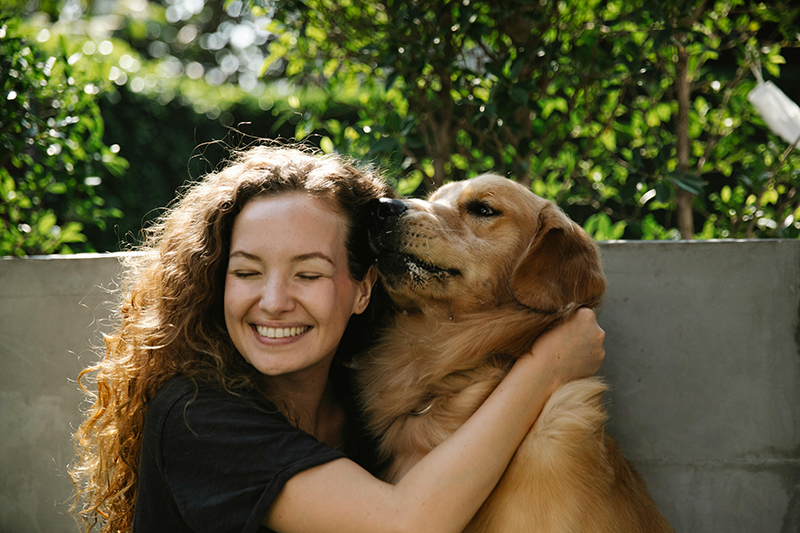
Leptospirosis is a Bacterial Disease Increasing in Dogs
The AVMA monitors the spectrum of diseases that affect animals and adjusts its recommendation as the environment changes. In recent years, the organization has recognized increasing leptospirosis cases in dogs and now recommends all dogs receive the lepto vaccination.
Leptospirosis is caused by the Leptospira bacteria, which is found in soil and water. It’s a zoonotic disease, which means it affects people and some animals, including dogs, livestock, rats, deer, opossums and skunks.
Veterinarian Dr. Myers explains how dogs may contract the disease:
“The bacteria is spread in the urine of infected animals. Dogs can contract the disease by coming into contact with infected urine in standing water, streams, lakes or recently contaminated soil. The bacteria can enter the body through the mouth, nose, eyes or a small cut in the skin or paw pad.”
Do We Need to Worry about Lepto in Cincinnati?
In one 14-year study on canine leptospirosis, researchers found that the disease is most common in the Midwest, East, Southwest and certain counties in Appalachia. Suburban areas and deciduous forests were locations with the highest probabilities of leptospirosis cases. The Cincinnati area matches this description, being in the Midwest region with large areas of forested suburbs.
Symptoms of Lepto
The AVMA reports that the symptoms of lepto in dogs start out fairly generalized:
- Loss of appetite
- Vomiting
- Lethargy
- Abdominal pain
- Diarrhea
- Jaundice (yellowing of the skin and mucous membranes)
- Dehydration
- Drinking or urinating more than usual
- Weight loss
- Stiffness or muscle pain
However, the disease can progress to life-threatening kidney and/or liver failure. Also, it can spread to humans.
Your dog and family will benefit from being vaccinated against leptospirosis. Contact us, and we’ll be glad to answer your questions and schedule an appointment.
Read More
What Are Heartworms?
April 23, 2024

Get the Facts on this Parasitic Worm
As the weather warms up, we’ve already experienced a few mosquito bites this year. These 10 facts about heartworms and the devastating disease they cause in pets are more important to know than ever.
- Heartworms are parasitic worms that live inside the heart, pulmonary arteries and/or lungs of an infected mammal
- Adult worms reproduce in the host animal and multiply in the bloodstream
- Dogs, cats, ferrets, wolves, coyotes and foxes can all contract heartworm disease
- One thing that makes them different from other parasitic worms? Most others infect the gastrointestinal tract, not the circulatory system
- Heartworms can grow to 14 inches in length
- Mosquitoes carry and spread heartworm larvae. When a mosquito bites a heartworm-infected animal (often wildlife), the larvae enters the mosquito along with the blood meal
- When a heartworm-carrying mosquito bites another animal (often a pet), the larvae spreads to that animal
- It takes months for heartworm disease to become visibly symptomatic in a pet. This is the time it takes for heartworm larvae to grow into adult worms
- Treatment in dogs is expensive, time-consuming and high-risk for the dog. There is no approved treatment for cats.
- Heartworm prevention is the best method to address heartworm disease for dogs and cats. Year-round prevention can come in several forms, from a monthly tablet to a combined flea-tick-and-heartworm medication. Ask your veterinarian which method is best for your pet and lifestyle
For more information, check out our recent article, “Heartworm Prevention: Be Aware!” And contact us if your Fairfield or Cincinnati-area pet is in need of heartworm prevention and other wellness care.
Read More
Parvo in Puppies: Don’t Risk It
April 16, 2024

Vaccinate Your Puppy On Time to Prevent this Deadly Infection
Parvovirus can affect dogs of any age, but parvo in puppies is of especial concern. This virus is highly contagious and significantly fatal, especially in younger animals with immature immune systems.
However, with vaccination, parvo in puppies is almost completely preventable. Veterinarians typically give the first shot at six to eight weeks old, and additional vaccinations are given every three weeks, for a total of four vaccinations.
Learning More about Parvo in Puppies
It’s estimated that 900 US dogs each day are diagnosed with parvovirus. The disease attacks the lining of the digestive tract and young immune cells. Symptoms are distressing and painful to the dog:
- Lethargy
- GI bleeding
- Bloody diarrhea
- Vomiting
- Dehydration
- Shock
- Sepsis
Puppies are more at-risk from the dangers of this GI virus, because of their small size and weaker immune system. Dehydration happens more rapidly and leads to the more severe symptoms.
Unvaccinated Dogs and Puppies Can Easily Catch Parvo
This virus is spread through contact with fecal matter of an infected dog. Some strains of parvovirus have the ability to live outside an animal for over a year.
Dr. Kathleen Aicher, assistant professor at the Texas A&M School of Veterinary Medicine & Biomedical Sciences, provides details on why parvovirus is highly contagious:
“Parvovirus is very easily transmitted between dogs because it takes very little exposure to cause infection, and dogs who are infected can shed the virus for a few days before they exhibit symptoms, unknowingly exposing other dogs to the virus. The virus is also very resistant to extreme temperatures and cleaning, so it can remain in the environment for a long time, putting dogs at further risk.”
Dangers of Canine Parvovirus– And Expense of Treatment
Once a dog contracts parvovirus, treatment is critical for survival. Shwntel F. Wilson of Westminster University in Salt Lake City writes:
“Mortality rates of canines with untreated parvovirus remain at 90 percent, while aggressively treated parvovirus has a significantly smaller mortality rate window of 5- 20 percent.”
Treatment usually includes hospitalization, which can last two to seven days. Patients require round-the-clock care, so the treatment of parvo in puppies is very costly. Sadly, even with early and aggressive treatment, there is still a significant chance of death.

Save the Puppies from Parvo!
There’s no need for puppies to endure parvovirus and face this tragic end. Vaccination builds your puppy’s immune system to fight off the virus.
Until your puppy has received its full round of parvovirus vaccinations, avoid public exposure to other dogs, like dog parks and kennels.
Learn more about immunization in pets, and contact us to schedule a new puppy wellness visit.
Read More
Immunization Awareness for Your Pets
August 7, 2023

It’s very important to keep your pets up-to-date on their vaccinations. The greatest form of protection against many illnesses your pet can get is by vaccinating them. We strongly recommend vaccinating your pets yearly to keep them protected.
Immunization vs. Vaccination:
What’s the Difference?
We often hear the words “immunization” and “vaccination” used interchangeably. But there is a difference between the two.
Vaccination is the act of receiving the vaccine, either by shot or orally. So, it’s accurate to say, “I’m taking my cat for her vaccines tomorrow.”
Immunization occurs once your pet has received their vaccine and their immune system has worked to become immune from the disease. After your veterinary vaccination appointment, you could say, “My dog has been immunized against Parvo.”

Common Vaccinations for Cats
There are three typical vaccinations that cats receive, and these protect against 5 different diseases.
- FVRCP: This combination vaccine protects against Feline rhinotracheitis virus/herpesvirus 1 (FVR/FHV-1), Feline Calicivirus (FCV), Feline Panleukopenia (FPV). FVR/FHV-1 causes severe upper respiratory infection, and the virus stays with the cat for life. During stressful times, the virus can reactivate. FCV also causes signs of upper respiratory infection and can be deadly in some cases. FPV is also known as feline parvovirus. It’s very contagious and often deadly for kittens.
- Rabies: Immunization against rabies has been very successful in the US. The CDC reports that there are only one to three human cases in the country each year. Unfortunately, over 250 cats contract rabies each year, usually from wildlife bites. It continues to be important (and legal) to vaccinate your cat.
- FeLV: Protects kittens and cats against feline leukemia virus. While this disease is not always fatal, it is highly contagious. It’s best to control the spread and prevent your cat from contracting it.
Depending on your cat’s age and risk factors, your veterinarian may recommend vaccination annually or less often.

Common Vaccinations for Dogs
The list of common vaccinations for dogs is longer than that for cats.
- DA2PP: This five-way vaccine protects against Distemper, Adenovirus I and II, Parvovirus and Parainfluenza. Sometimes called DHPP or DAPP. All of these diseases are dangerous and contagious, making this a critical core vaccination for dogs.
- Rabies: Just like for cats, preventing rabies is very important, and it’s the law.
- Bordetella: Bordetella causes kennel cough, which is a common and contagious disease, especially common in dogs that board.
- Parainfluenza: Another agent that causes kennel cough.
- Leptospirosis: This bacterial disease is spread via the urine of infected animals. It can cause kidney or liver failure.
- Lyme: Spread through ticks, Lyme disease causes several symptoms such as fever, lethargy or even kidney failure.
- Canine influenza: This highly-contagious disease causes cough, nasal discharge and low-grade fever.
If it’s been awhile since your pet’s last wellness visit, make an appointment to get up-to-date on vaccinations. Prevention is so much better than trying to cure one of these diseases once they take hold.
Read More
Rabies: The 100% Preventable Killer
September 23, 2021
World Rabies Day is September 28
Around the world, more than 59,000 humans die from rabies each year, reports the CDC. It’s important to know that once symptoms show up, rabies is practically 100% fatal. It is also 100% preventable.

Bats are the Main Culprit in the US
In the US, just one or two people die each year from rabies. The CDC writes:
In the United States today, human fatalities are rare but typically occur in people who do not seek prompt medical care. While the exact reason for not seeking care is often unclear, lack of awareness of the risk of rabies is thought to be an important factor. This is of particular concern for bat bites, since bats can have small teeth and leave bite marks that are the size of the tip of a pencil…. Of the infections acquired in the United States, 70% were attributed to bat exposures.
While today bats are of most concern in the US, that wasn’t always the case. Before 1960, most reported cases of rabies were in dogs. During that time, 100 people per year might die of rabies. The CDC attributes this change to:
“This decline can be attributed to successful pet vaccination and animal control programs, public health surveillance and testing, and availability of post-exposure prophylaxis (PEP) for rabies.”
It should be noted that the vast majority of bats don’t have rabies. Among sick or injured bats that have been captured for rabies testing, only 6% of them are infected. When left alone in their wild environment, bats are an important part of our ecosystem.
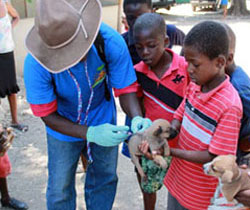
Worldwide, Dogs Still Need Rabies Protection
A global coalition of health organizations “are working together to eliminate human deaths from dog-transmitted rabies by 2030.” The CDC describes examples of its work in Ethiopia, Vietnam and Haiti, where public health workers promote and distribute rabies vaccinations to dogs.

What Can You Do to Prevent Rabies?
The spread of rabies has become less severe in the US because we have taken steps as a society to prevent this fatal disease. Here’s how you can help:
- Most importantly, keep your cat or dog’s rabies vaccination up-to-date. (Yes, even indoor cats. Believe it or not, bats can enter a home and bite people or animals sleeping inside).
- Keep your pets away from wildlife.
- If you work in a field where you have a higher than normal risk of contracting rabies, you may personally benefit from a pre-exposure rabies vaccine. Occupations include veterinarians, animal handlers and veterinary students.
- Know the signs of rabies and report any sightings to animal control or your local health department.
- Never pick up or touch a dead animal.
Read More
Immunization Awareness Month is for Pets, Too
August 4, 2021
Cats and Dogs Can’t Get COVID, but Their Vaccines Can Be Just as Life-Saving for Them
In the last year, it’s been tempting to delay pet wellness visits and get off schedule with your cat or dog’s vaccinations. Veterinarians around the country understand that. During Immunization Awareness Month, we are taking the time to remind pet owners of the importance of keeping your pet’s shots up to date.
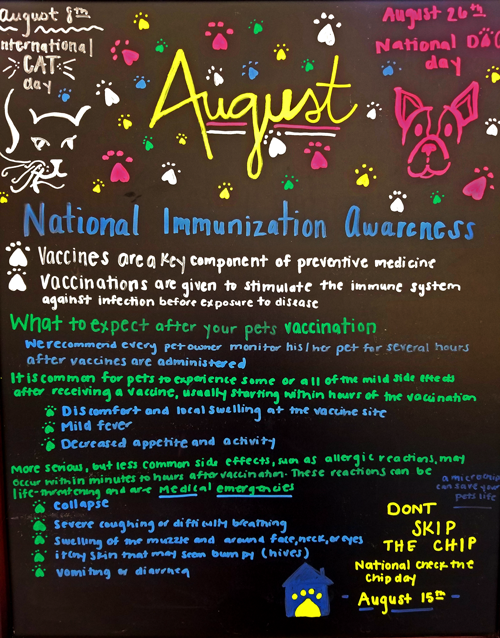
Preventative Medicine is Safer and Less Expensive
Vaccinations are a critical part of your pet’s health and wellness because they prevent dangerous conditions. Vaccinations are given to stimulate the immune system against infection before exposure to disease ever occurs.

How Vaccinations Protect Your Cat
There are serious diseases for cats that can be prevented entirely with immunization. Side effects are generally mild, especially compared with the importance of prevention.
These are standard vaccinations for cats:
- Feline leukemia (FIV)
- Feline viral rhinotracheitis
- Feline Panleukopenia
- Rabies
- Feline Calieivirus
In addition, you may also want to consider these vaccinations for your cat:
To grow into a healthy cat, kittens should be vaccinated for the first time between 6-8 weeks of age. Second booster doses are generally given at 10-12 weeks, and again at 14-16 weeks. Adult cats who have been fully vaccinated receive boosters every 1-3 years.

How Vaccinations Protect Your Dog
Unvaccinated dogs are typically at even greater risk for contracting disease, because they are more likely to go outside and come in contact with others than an indoor cat.
These are standard vaccinations for dogs:
- Canine distemper
- Canine parvovirus
- Infectious canine hepatitis
- Rabies
- Canine influenza (dog flu)
- Canine Tracheobronchitis (canine cough)
In addition, you may also want to consider these vaccinations for your dog:
- Leptospirosis
- Lyme disease
Puppies also start a vaccination schedule around 6-8 weeks, and receive boosters at 10-12 weeks and 16-18 weeks. As adult dogs, they receive boosters every 1-3 years, depending on the type of vaccine. It should be noted that the rabies vaccine is required by law every 3 years.
Have questions about your pet’s immunization or want to know if they are up-to-date? Contact us.
Read More
Vaccinate On Time to Prevent Serious Pet Illnesses
August 25, 2020
August is National Immunization Awareness month, and immunizations are just as important for pets as for people!
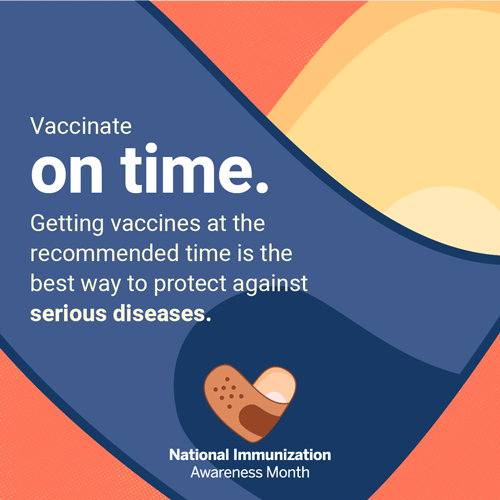
 Puppy and Kitten Vaccinations
Puppy and Kitten Vaccinations
We recommend starting vaccination with puppies and kittens as early as six to eight weeks of age.
These are standard vaccinations for cats:
- Feline leukemia (FIV)
- Feline viral rhinotracheitis
- Feline Panleukopenia
- Rabies
- Feline Calieivirus
In addition, you may also want to consider these vaccinations for your cat:
These are standard vaccinations for dogs:
- Canine distemper
- Canine parvovirus
- Infectious canine hepatitis
- Rabies
- Canine influenza (dog flu)
- Canine Tracheobronchitis (canine cough)
 In addition, you may also want to consider these vaccinations for your dog:
In addition, you may also want to consider these vaccinations for your dog:
- Leptospirosis
- Lyme disease
- Canine coronavirus
Vaccinations for Adult Dogs and Cats
Immunization in pets doesn’t last for life. For dogs, receiving a DAPP booster annually protects against distemper virus, adenovirus type 1 and type 2, canine parainfluenza virus and parvovirus. A rabies vaccination needs a booster after the first year then on a regular schedule after that. A bordetella vaccination is administered every year or six months. Dogs are also recommended to receive a canine influenza vaccine annually.
Cats receive an annual FVRCP booster to prevent rhinotracheitis, calicivirus, and Panleukopenia (distemper). Cats may also be required to receive rabies vaccines every one to three years, as well.
If it’s been awhile since your pet’s last check-up, it’s probably time to ask about vaccine boosters. Let’s keep our cats and dogs healthy!
Read More
National Immunization Awareness in August
August 5, 2019

Vaccinations are a Critical Part of Your Pet’s Health and Wellness
 Preventative medicine is always better for your pet (and less expensive, too!). Vaccinations are given to stimulate the immune system against infection before exposure to disease ever occurs.
Preventative medicine is always better for your pet (and less expensive, too!). Vaccinations are given to stimulate the immune system against infection before exposure to disease ever occurs.
What to Expect After Your Pet’s Vaccination
We recommend every pet owner monitor their pet for several hours after vaccines are administered. It is common for pets to experience some or all of the following mild side effects after receiving a vaccine, usually starting within hours of vaccination:
- Discomfort and local swelling at the vaccine site
- Mild fever
- Decreased appetite and inactivity
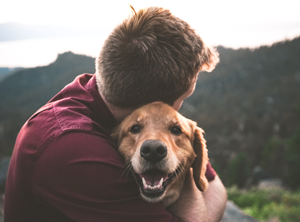 More Serious, but Less Common Side Effects
More Serious, but Less Common Side Effects
Uncommon but serious side effects, such as allergic reactions, may occur within minutes to hours after vaccination. These reactions can be life-threatening and are medical emergencies. Watch for these signs:
- Collapse
- Severe coughing or difficulty breathing
- Swelling of the muzzle and around face, neck or eyes
- Itchy skin that may seem bumpy (hives)
- Vomiting or diarrhea
If you have any questions about your pet’s health, please give us a call at (513) 829-8989.
Read More
Remember Your Flea & Tick Preventative in May
May 7, 2019
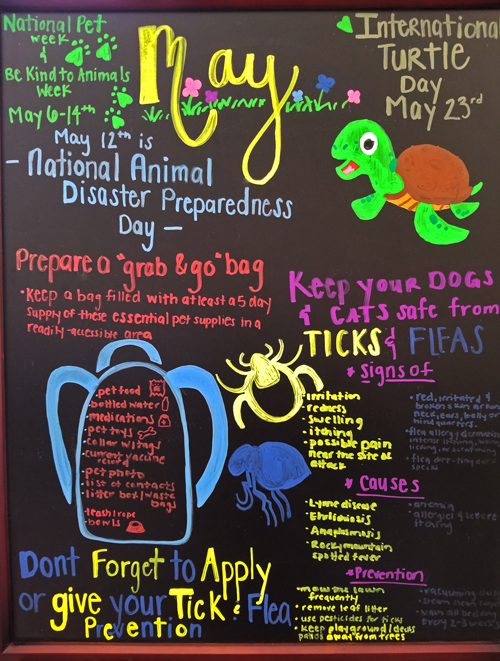
Keep Your Dogs & Cats Safe from Ticks & Fleas
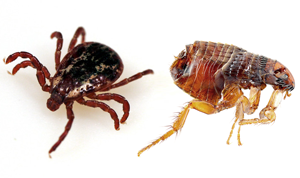 Ticks and fleas are coming out in force. According to the CDC, “Lyme disease in Ohio pets is up 76 percent from 2017 to 2018.” Additionally, there’s a warning that the Asian longhorned tick is on a march to Ohio and West Virgina.
Ticks and fleas are coming out in force. According to the CDC, “Lyme disease in Ohio pets is up 76 percent from 2017 to 2018.” Additionally, there’s a warning that the Asian longhorned tick is on a march to Ohio and West Virgina.
Signs Of…
Ticks
|
Fleas
|
- Irritation
- Redness
- Swelling
- Itching
- Possible pain near the site of attack
|
- Red, irritated and broken skin around neck, ears, belly or hindquarters
- Flea allergy dermatitis: intense itching, biting, licking or scratching
- Flea dirt: tiny dark specks
|
They Cause…
Ticks
|
Fleas
|
- Lyme disease
- Ehrlichiosis
- Anaplasmosis
- Rocky Mountain spotted fever
|
- Anemia
- Allergies
- Severe itching
|
How to Prevent…
Ticks
|
Fleas
|
- Mow the lawn frequently
- Remove leaf litter
- Use pesticides for ticks
- Keep playgrounds, decks and patios away from trees
|
- Vacuuming daily
- Steam clean carpet
- Wash all bedding every 2-3 weeks
|
If you have any questions about your pet’s health, please give us a call at (513) 829-8989.
Read More

















 Puppy and Kitten Vaccinations
Puppy and Kitten Vaccinations In addition, you may also want to consider these vaccinations for your dog:
In addition, you may also want to consider these vaccinations for your dog: Preventative medicine is always better for your pet (and less expensive, too!). Vaccinations are given to stimulate the immune system against infection before exposure to disease ever occurs.
Preventative medicine is always better for your pet (and less expensive, too!). Vaccinations are given to stimulate the immune system against infection before exposure to disease ever occurs. More Serious, but Less Common Side Effects
More Serious, but Less Common Side Effects
 Ticks and fleas are coming out in force.
Ticks and fleas are coming out in force.